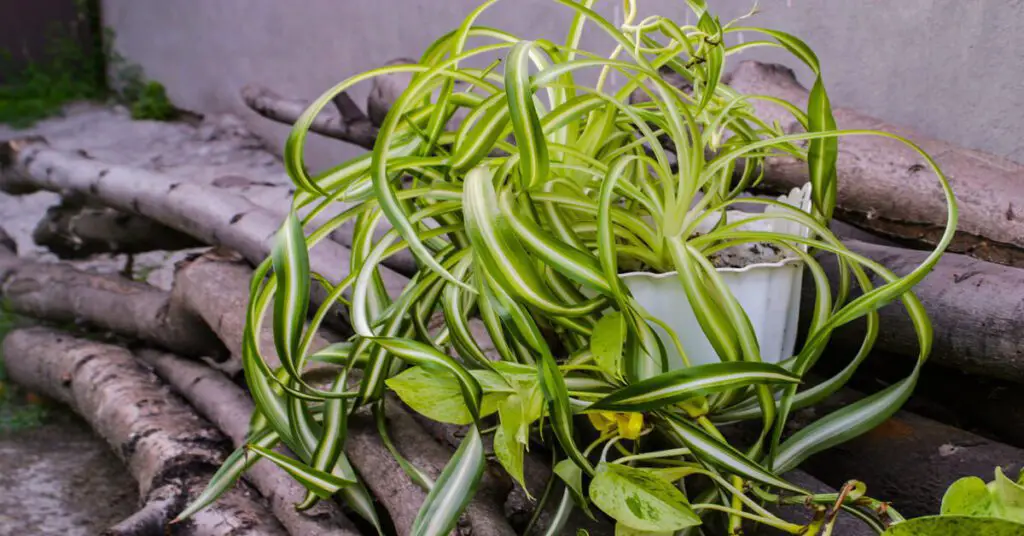Native to Southern Africa (and also naturalized to Australia and Bangladesh), the curly spider plant (Chlorophytum comosum “Bonnie”) cultivar is similar to the regular spider plant, except for its more compact size and curly leaves.
Bonnie plants also come in two versions: the curly, regular green-leaf version and the curly, creamy white-striped colored version (aka variegated Bonnie spider plant).
Spider plants are part of the Asparagaceae family, which includes members such as the asparagus, agave, hyacinths, yucca, and snake plants. The family includes over 114 genera and ~2,900 known species.
In the famous 1989 NASA air purification study, spider plants were runner-up for their effectiveness in filtering out air toxins such as formaldehyde and xylene in controlled conditions (first place went to peace lilies).
Curly Spider Plant Care
Spider plant “Bonnie” can grow up to 8 inches tall (0.2 m) and spread to about 16 inches (0.4m) when mature.
They fit perfectly on a countertop or can be hung from a hanging basket, especially when they start developing white flowers off their wiry, yellow flowering stems.
These plants tend to be easy to propagate, tolerant of neglect, and will thrive in nearly any condition.
Their easy-going nature, coupled with their compact size and striking perm, make them perfect indoor plants for the beginner enthusiast.
Soil
“Bonnie” prefers moist humus soil with a little bit of potting compost. We recommend adding ¼ part perlite to help the moist soil drain properly.
Watering
Bonnie tends to get thirsty, but doesn’t mind a little forgetfulness, as it is drought-tolerant. Allow the soil to dry 1-2 inches down between waterings.
Lighting
Bright, indirect sunlight is ideal. Direct sunlight will lead to leaf scorch. An east- or west-facing window works best.
Humidity & Temperature
Spider plants are not too fussy, so average humidity (40-60%) and cool to average temperatures (65-75°F or 18-23°C) are ideal.
Of course, these plants can tolerate warmer and drier conditions as well, but maintain the medium to high humidity for best foliage. Avoid drafty cold windows and temperatures below 50°C.
Fertilizing
Fertilize every 3-4 months (during early spring to late autumn) using diluted common household liquid fertilizer. Spider plants won’t pout if you forget to fertilize them.
However, over-fertilizing will cause fewer plantlets to form, as well as brown the tips.
Propagation
Propagation is extremely easy from the “spiders” or baby plantlets that grow from the mother plants.
Lay the baby plantlets (still attached to their mothers) on top of a second pot filled with the recommended potting soil mix and allow the babies to take roots before severing from their mothers.
To ensure the baby plantlets grow roots, use a paper clip or piece of wire to secure them so that the baby plantlets make contact with soil.
Alternatively, you can use baby plantlets that have already developed roots and plant them. Baby plantlets will also grow roots in water before transplanting.
Lastly, it’s also possible to grow via seeds, but seedlings will not necessarily have the same leaf coloration as their parents.
Diseases & Pests
These plants generally have few pest problems, other than the occasional scale insects and mealybugs. Overwatering or planting in poorly draining soil will also cause root rot.
Toxicity
According to the ASPCA and University of California Agriculture and Natural Resources, spider plants are safe and non-poisonous to both pets and people.
Chlorophytum comosum babies
Sometimes called spiderettes, the curly spider plant’s babies are essentially plantlets that develop on the runners. These can easily be planted to develop new plants while still attached to their mothers or in water via cuttings.
Curly Spider Plant with Brown Tips
Avoid overfertilizing your spider plants, as this can cause leaves to develop brown tips. Other causes include overwatering, low humidity, and cold drafty air.
Spider plants are also very sensitive to the fluoride in tap water, so use distilled or rain water when possible.
Spider Plant vs Curly Spider Plant
Both curly spider plants (Bonnie) and regular spider plants have long, thin, grass-like leaves with white streaks. Bonnie plants, however, tend to be more compact, and their leaves are also curly and bending vs. straight on the regular spider plants. Bonnies also tend to be slower growing than regular spider plants.

